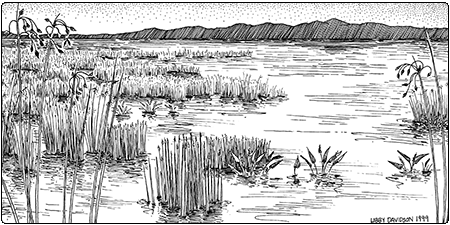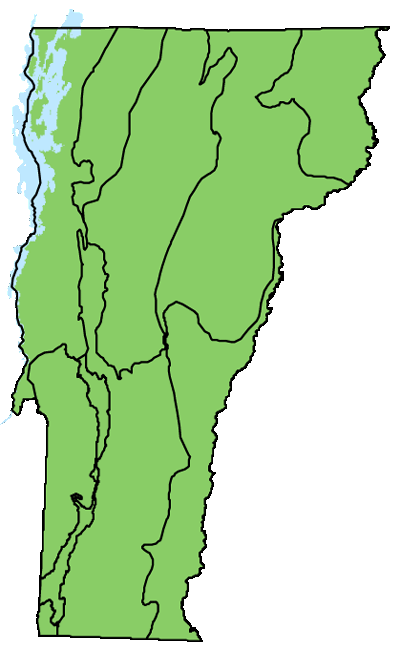Ecology and Physical Setting 
When viewed from a distance, either from on shore or from adjacent open water, Deep Bulrush Marshes appear as dense stands of dark, blue-green vegetation. However, on closer inspection the tall, slender stems of bulrush in deep water may be far apart and easily pushed aside to allow passage of a canoe. In shallower water, bulrush stands may be denser and more difficult to paddle through.
Deep Bulrush Marshes occur in open water along the shores of lakes and ponds, and the backwaters of slow-moving rivers. On larger lakes, like Lake Champlain and Lake Memphremagog, Deep Bulrush Marshes may be subject to the strong forces of wave action and ice scour. In these situations, the substrate is typically a rather coarse mineral soil. On smaller ponds and in sheltered bays of larger lakes, the soils may have more organic content. In both situations, the soils are held in place and the shoreline stabilized from erosion by the mat of bulrush roots.

Deep Bulrush Marshes are permanently inundated and typically have water depths from one to three feet. In dry years, soils may be exposed. Lakeward from Deep Bulrush Marshes on lakes with significant wave action, there is usually only open water. On smaller ponds or in sheltered settings, Bulrush Marshes may grade into aquatic communities with floating-leaved and submersed plants. Towards shore, Bulrush Marshes are often adjacent to sand or shale beaches, but can grade into Deep Broadleaf Marshes and Cattail Marshes in sheltered locations. It is common for all of these deepwater marshes and shallow aquatic communities to intergrade and form mosaics. The clonal growth habits of many marsh and aquatic plants are partly responsible for these mosaic patterns.
Strong wave action associated with storms is a source of natural disturbance in Deep Bulrush Marshes. Unlike many emergent marsh plants, the thin, smooth bulrush plants are well adapted to withstand waves and wind. Occasionally, patches may be uprooted by persistent breaking waves or ice action. Muskrats may also clear areas of bulrush when collecting building material for their lodges.
Vegetation

Marshes, has a distinctive drooping flower cluster.
Deep Bulrush Marshes, especially those marshes subject to wave action and ice scour, are generally low in plant species richness. Soft-stem bulrush and hard-stem bulrush dominate most of these marshes. River bulrush is abundant in some marshes along the shores of Lake Champlain. Marsh spikerush is a common species associated with this community. Other species of emergent plants that may be present in more sheltered settings or shallower water include pickerelweed, broad-leaved arrowhead, and giant bur-reed. Scattered, submersed aquatic plants, such as pondweeds, common coontail, and waterweed, grow among the emergent plants.
Wildlife Habitat
Several rare marsh birds—including pied-billed grebes, common gallinules, American coots, and least bitterns—use Deep Bulrush Marshes for feeding and raising their young. Many species of dabbling and diving ducks also use these marshes, both during the breeding season for rearing young and during spring and fall migrations as feeding and resting stopovers. Painted turtles may be seen basking on floating logs. Snapping turtles, and rare spiny softshells and eastern musk turtles, all primarily aquatic, may be present feeding on or near the bottoms of these marshes.
Related Communities
- Deep Broadleaf Marsh usually occurs in water that is more sheltered than Deep Bulrush Marshes. Pickerelweed, arrowheads, and bur-reeds dominate.
Conservation Status and Management Considerations
The water levels of many of Vermont’s lakes and ponds are controlled by dams at their outlets. Maintaining natural lake level fluctuations is important to the ecological integrity of these wetlands. Beach raking and other artificial shoreline manipulations can threaten these marshes and their abundant wildlife. Canoe and kayak paddlers can also disturb secretive marsh birds and disrupt their nesting success.
Distribution/Abundance
Found throughout Vermont on lakes and slow rivers. Similar communities occur throughout the northeastern United States and adjacent Canada.
Characteristic Plants
Herbs
Abundant Species
Soft-stem bulrush – Schoenoplectus tabernaemontani
Hard-stem bulrush – Schoenoplectus acutus
Occasional to Locally Abundant Species
River bulrush – Bolboschoenus fluviatilis
Marsh spikerush – Eleocharis palustris
Three-square – Schoenoplectus pungens
Pickerelweed – Pontederia cordata
Broad-leaved arrowhead – Sagittaria latifolia
Giant bur-reed – Sparganium eurycarpum
Pondweeds – Potamogeton spp.
Common coontail – Ceratophyllum demersum
Waterweed – Elodea canadensis
Non-native Invasive Plants
Water chestnut – Trapa natans
Flowering rush – Butomus umbellatus
Rare and Uncommon Plants
Slender bulrush – Schoenoplectus heterochaetus
Lake-cress – Rorippa aquatica
Associated Animals
American bullfrog – Lithobates catesbeianus
Snapping turtle – Chelydra serpentina
Painted turtle – Chrysemys picta
Muskrat – Ondatra zibethicus
Marsh wren – Cistothorus palustris
Lance-tipped darner – Aeshna constricta
Dot-tailed whiteface – Leucorrhinia intacta
Rare and Uncommon Animals
Common watersnake – Nerodia sipedon
Spiny softshell – Apalone spinifera
Eastern musk turtle – Sternotherus odoratus
Pied-billed grebe – Podilymbus podiceps
Common gallinule – Gallinula galeata
Least bittern – Ixobrychus exilis
Black tern – Chlidonias niger
American coot – Fulica americana
Places to Visit
Missisquoi National Wildlife Refuge, Swanton and Highgate, U.S. Fish and Wildlife Service
Drowned Lands, West Haven, Helen W. Buckner Preserve at Bald Mountain, The Nature Conservancy
South Bay Wildlife Management Area, Coventry, Vermont Fish and Wildlife Department (VFWD)
Sandbar Wildlife Management Area, Milton, VFWD
